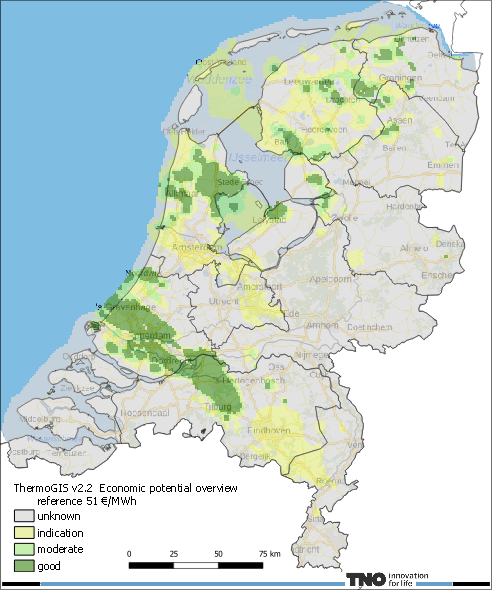ThermoGIS is an online web tool that shows the potential of geothermal and HT-ATES. Geothermal energy is an amalgamation of the Greek “geo” (earth) and “thermos” (heat) and is also known as geothermal heat. It is a renewable energy source that is not weather or seasonal dependent. HT-ATES stands for High Temperature Aquifer Thermal Energy Storage, and is (seasonal) storage of heat in the subsurface.
ThermoGIS translates geological data and knowledge into a model of the subsurface. It shows maps of the depth, thickness, permeability and temperature of rock layers from which geothermal heat can potentially be extracted or where the subsurface can be used for high temperature storage (HT-ATES).
The geothermal and HT-ATES potential was calculated using a techno-economic calculation module. This takes into account both technical (how much heat can be produced) and economic aspects (what does it cost).
The potential maps of the Netherlands can be viewed using the Mapviewer (see the Tips & tricks page for help navigating the Mapviewer). Among other things, the potential maps show what the achievable flow rate can be, but also the temperature of the production water or the geothermal power. Finally, they show what, approximately, the costs are relative to the SDE base amount.
The “Calculation tab” of the Mapviewer allows the geothermal potential to be calculated for a specific location. Key parameters can be adjusted to see their impact on the calculation. The Technical Information page explains how the geothermal potential maps were created. The maps are publicly available and can be requested here.

ThermoGIS is being developed by the Geological Survey of the Netherlands, part of TNO (TNO-GDN). The development uses subsurface knowledge and data available through NLOG. ThermoGIS is continuously updated, expanded and improved where necessary. You can read all about this at ‘New Developments’.
Disclaimer
ThermoGIS shows only strata with potential for geothermal and HT-ATES. The natural properties of these strata, also called aquifers, are favourable enough to extract sufficient water. The mapping of strata depends in part on data availability and data density. Therefore, certain layers may not be included in ThermoGIS because not enough is known about them. The maps in ThermoGIS are mapped and modelled on a regional scale. Locally, therefore, the values shown may differ from reality.
As soon as new data become available, for example from the SCAN program, the map images may change. GDN-TNO strives to regularly update the maps in ThermoGIS.
